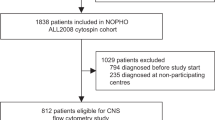Abstract
An independent clinical assessment was compared with flow cytometry (FCM) and cytomorphology results obtained on 227 cerebrospinal fluids investigated for hematologic malignancy, in a retrospective longitudinal study with a median observation time of 11 months. A combined method assessment (CMA), defining “positive” a sample if at least one method gave “positive” results, was also tested. Eleven out of 55 screening samples and 53 out of 166 follow-up samples resulted positive at clinical evaluation. FCM and CM were concordant with positive clinical assessment in 68.5% and 51.5% of cases, respectively. According to CMA, 10.5% of samples (resulting false negative by either FCM or cytomorphology) were rescued as true positive. FCM retained significantly higher accuracy than cytomorphology (p = 0.0065) and 100% sensitivity when at least 220 leukocytes were acquired. CMA accuracy was higher than FCM accuracy and significantly higher than cytomorphology accuracy in the analysis of all samples (p < 0.0001), samples from mature B/T cell neoplasms (p = 0.0021), and samples drawn after intrathecal treatment (p = 0.0001). When acquiring ≤220 leukocytes, FCM accuracy was poor, and combining cytomorphology added statistically significant diagnostic advantage (p = 0.0043). Although FCM is the best diagnostic tool for evaluating CSF, morphology seems helpful especially when clinically positive follow-up samples are nearly acellular.
Similar content being viewed by others
References
Schinstine M, Filie AC, Wilson W, Stetler-Stevenson M, Abati A (2006) Detection of malignant hematopoietic cells in cerebral spinal fluid previously diagnosed as atypical or suspicious. Cancer Cytopathol 108:157–162
Finn WG, Peterson LC, James C, Goolsby CL (1998) Enhanced detection of malignant lymphoma in cerebrospinal fluid by multiparameter flow cytometry. Am J Clin Pathol 110:341–346
French CA, Dorfman DM, Shaheen G, Cibas ES (2000) Diagnosing lymphoproliferative disorders involving the cerebrospinal fluid. Increased sensitivity using flow cytometric analysis. Diagnostic Cytopathol 23:369–374
Sayed D, Badrawy H, Ali AMA, Shaker S (2009) Immunophenotyping and immunoglobulin heavy chain gene rearrangement analysis in cerebrospinal fluid of pediatric patients with acute lymphoblastic leukaemia. Leuk Res 33:655–661
Bromberg JEC, Breems DA, Kraan PhDJ, Bikker G, van der Holt B, Sillevis Smith P, van den Bent MJ, van’t Veer M, Gratama JW (2007) CSF flow cytometry greatly improves diagnostic accuracy in CNS hematologic malignancies. Neurology 68:1674–1679
Hegde U, Filie A, Little RF, Janik JE, Grant N, Steinberg SM, Dunleavy K, Jaffe ES, Abati A, Stetler-Stevenson M, Wilson WH (2004) High incidence of occult leptomenigeal disease detected by flow cytometry in newly diagnosed aggressive B-cell lyphomas at risk for central nervous system involvement. The role of cytometry versus cytology. Blood 105:496–502
Di Noto R, Scalia G, Abate G, Gorrese M, Pascariello C, Raia M, Morabito P, Capone F, Lo Pardo C, Mirabelli P, Mariotti E, Del Vecchio L (2008) Critical role of multidimensional flow cytometry in detecting occult leptomeningeal disease in newly diagnosed aggressive B-cell lymphomas. Leuk Res 32:1196–1199
Quijano S, Lopez A, Sancho JM, Panizo C, Deben G, Castilla C, Garcia-Vela JA, Salar A, Alonso-Vence N, Gonzalez-Barca E, Penalver FJ, Plaza-Villa J, Morado M, Gargia-Marco J, Arias J, Briones J, Ferrer S, Capote J, Nicolas C, Orfao A (2009) Identification of leptomeningeal disease in aggressive B-cell non-Hodgkin’s lymphoma: improved sensitivity of flow cytometry. J Clin Oncol 27:1462–1469
Subirà D, Castanon S, Roman A, Aceituno E, Jimenez-Garofano C, Jimenez A, Garcia R, Bernacer M (2001) Flow cytometry and the study of central nervous disease in patients with acute leukaemia. Br J Haematol 112:381–384
Roma AA, Garcia A, Avagnina A, Rescia C, Elser B (2002) Lymphoid and myeloid neoplasm involving cerebrospinal fluid: comparison of morphologic examination and immunophenotyping by flow cytometry. Diagnostic Cytopathol 27:271–275
Urbanits S, Griesmacher A, Hopfinger G, Stockhammer G, Karimi A, Muller MM, Pittermann E, Grisold W (2002) FACS analysis—a new and accurate tool in the diagnosis of lymphoma in the cerebrospinal fluid. Clin Chim Acta 317:101–107
Wu JM, Gerrgy MF, Burroughs FH, Weir EG, Rosenthal DL, Ali SZ (2009) Lymphoma, leukemia, and pleiocytosis in cerebrospinal fluid. Is accurate cytopathologic diagnosis possible based on morphology alone? Diagnostic Cytopathol 37:820–823
Peter A (1974) Cytological changes in the cerebrospinal fluid following intrathecal methotrexate treatment. Confin Neurol 36:186–196
Cesana C, Klersy C, Scarpati B, Brando B, Volpato E, Bertani G, Faleri M, Nosari A, Cantoni S, Ferri U, Scampini L, Barba C, Lando G, Morra E, Cairoli R (2010) Flow cytometry vs cytomorphology for the detection of hematologic malignancy in body cavity fluids. Leuk Res 34:1027–1034
DeLong ER, DeLong DM, Clarke-Pearson DL (1988) Comparing the areas under two or more correlated receiver operating characteristic curves: a nonparametric approach. Biometrics 44:837–845
Tomita N, Kodama F, Kanamori H, Motomura S, Ishigatsubo Y (2002) Prophylactic intrathecal methotrexate and hydrocortisone reduces central nervous system recurrence and improves survival in aggressive non-Hodgkin lymphoma. Cancer 95:576–580
McMillan A (2005) Central nervous system-directed preventative therapy in adults with lymphoma. Br J Haematol 131:13–21
Hill QA, Owen RG (2006) CNS prophylaxis in lymphoma: who to target and what therapy to use. Blood Rev 20:319–332
Nowakowski GS, Call TG, Morice WG, Kurtin PJ, Cook RJ, Zent CS (2005) Clinical significance of monoclonal B cells in cerebrospinal fluid. Cytometry B Clin Cytom 63B:23–27
Schmidt-Hieber M, Thiel E, Keilholz U (2005) Spinal paraparesis due to leukemic meningitis in early-stage chronic lymphocytic leukaemia. Leuk Lymph 46:619–621
Author information
Authors and Affiliations
Corresponding author
Rights and permissions
About this article
Cite this article
Cesana, C., Klersy, C., Scarpati, B. et al. Flow cytometry and cytomorphology evaluation of hematologic malignancy in cerebrospinal fluids: comparison with retrospective clinical outcome. Ann Hematol 90, 827–835 (2011). https://doi.org/10.1007/s00277-010-1145-4
Received:
Accepted:
Published:
Issue Date:
DOI: https://doi.org/10.1007/s00277-010-1145-4




